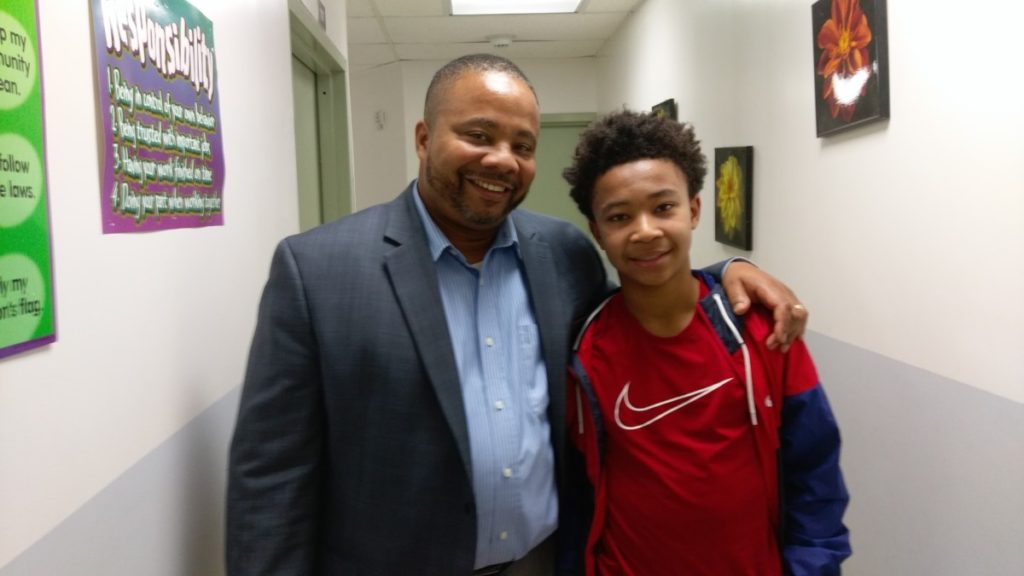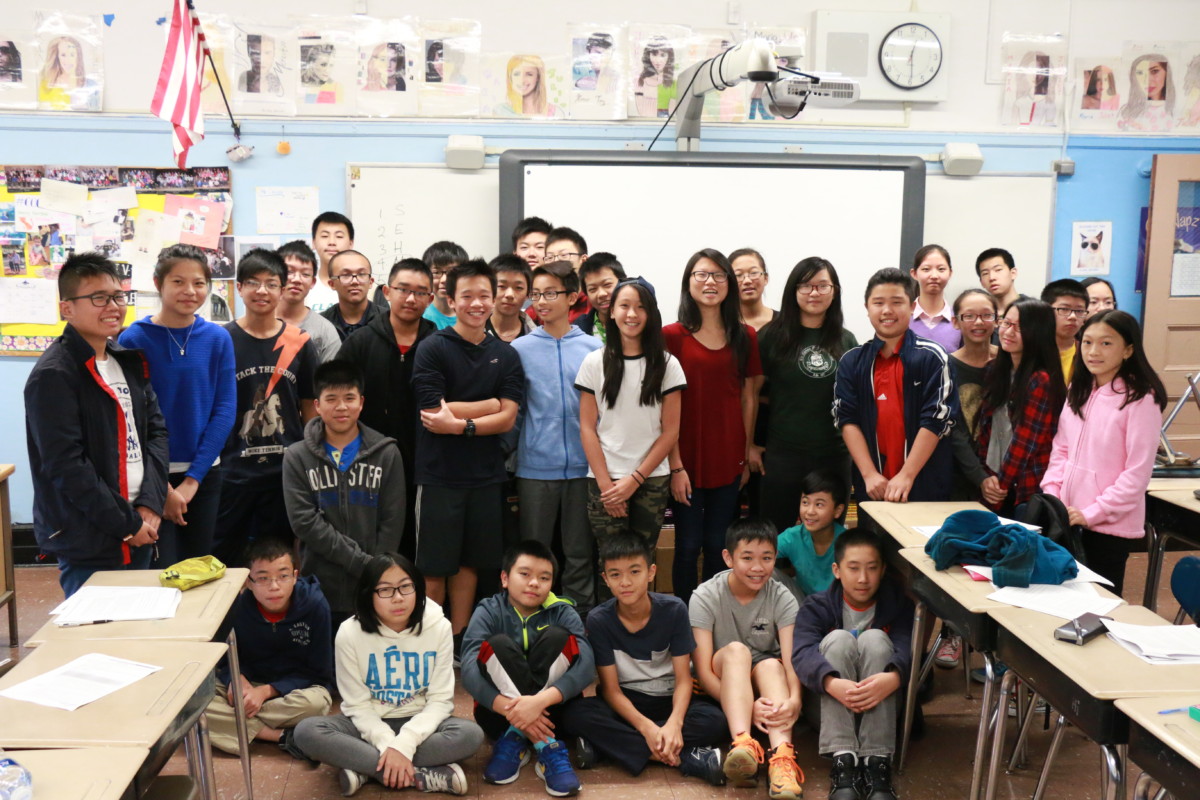On a recent Saturday morning at Angel Advantage Center Sunset Park Branch, Andrew Zhou was preparing for the upcoming Specialist High School Admissions Test (SHSAT). He had studied with Angel for two and half years, and he looked confident and determined. “But I’m also nervous because there are a lot of people competing,” Zhou said. When asked about his dream school, Zhou said “Stuyvesant” without hesitation: “’Stuy’ or die.”
Zhou started at Angel—with a lack of confidence and a burst of resentment because he was burdened with medical problems and responsibilities at home. But he improved steadily, and got better both academically and socially while studying at Angel. “He wouldn’t talk to anyone when he first came here,” said Danielle McKenna, Zhou’s English teacher. “He has grown so much and is now a wonderful student overall.”
Both of Zhou’s parents work at a restaurant. Like most first-generation Chinese immigrants, they’ve worked hard to survive in this foreign land since moving here 15 years ago. “My work often finishes after 10 p.m.” Zhou’s mother, Pan Deng Jiang said. “Their father is even busier.”
Zhou, 12, needs to take care of himself and his younger sister when his parents are working. Zhou described his typical day preparing for the SHSAT this past summer. While other kids might be at camp or in a park, Zhou pushed himself to improve his academics: “I get up at around 7 and go to school at 8. I have class until 4, and my aunt will pick me up and get me home. At home I will cook for my sister at around 5, and I’ll do my homework until 8, then I have to make dinner for her, and if there is laundry I’d do that, too. After that, I’ll just continue studying, at around 10 or 11, I’ll take a shower and go to sleep,” Zhou said.
The SHSAT test puts a lot of stress on young minds. In 2016, 26,971 testers were competing for 5,106 spots in the eight specialized high schools. The students and their parents know that graduating from these prestigious schools over non-specialized high school could be the difference between a more promising path to Ivy League placement after college, and a less favorable option. So the stakes are high.
“He’s not necessarily naturally gifted, but he definitely works twice as hard as anyone else,” said Siu Ming Lau, the director of Angel. She pointed out that Zhou’s academic excellence was a result of his work ethic and what he expects from himself. “But he’s only 12, there is so much on his shoulders.”
Zhou went through a series of difficult surgeries on his back and around his head when he was in fourth grade. He missed a lot of classes at school and fell behind. His mother heard about Angel prep center from Zhou’s classmates when he was in the second half of fifth grade, so she decided to send him there.
“We know nothing about education here, there is no way I can help him with his studies but sending him to the prep center, so I sent him to the weekend classes as well as summer classes,” Jiang said.
Test preparation doesn’t come cheap. It costs more than $1,500 for the whole year program for seventh grade students. According to Lau, a lot of parents don’t have a high school diploma and are from low-income backgrounds. “They wouldn’t go out for dinner to save money for these prep programs for their kids,”Lau said.
In District 20, which includes Sunset Park and part of Bensonhurst, 70 percent of the total students enrolled in public education are categorized as “Economically Disadvantaged.”
Vivian Louie, Associate Professor of Education at Harvard University, finds that the family and the institutional mechanisms (including teachers, peers, and other enrichment programs) play an important role in immigrant kids doing well in school, and in the process making up for their parent’s sacrifices, according to her books, Compelled to Excel and Keeping the Immigrant Bargain.
At another prep center, APlus Academy in Bensonhurst, Jesse Hamilton (IV), an African-American teenager from Crown Heights, also prepared for the SHSAT. His father Jesse Hamilton (III) drove him to the test center five days a week throughout summer.

When asked why he makes such an effort, driving his son all the way to Bensonhurst for the prep program, Hamilton senior said that while the public school does offer a prep program for the SHSAT, it starts too late. The program begins in September but the final test is in October.
“You can’t rely on the schools,” said the senior Hamilton. “The board of education in New York City doesn’t prepare enough materials or programs in the districts of color, because of low expectations.”
In 2016, 29.9 percent of students taking the SHSAT were Asian and 21.9 percent were African-American. But among the students who were offered a spot at these specialized high schools, Asian students make up 53.7 percent, while African-American students only make up 4.1 percent.
“Parents are being put to sleep because your child comes home with A’s. What happens is they are getting high marks and not doing well, ” Hamilton said, of why African-American students are doing poorly on the test. “It makes the teacher look good, it makes the parents feel happy, but at the end of the day, the children aren’t learning what they need to know. ”
When the elder Hamilton was young, he said, his mom had to choose between him and his sister for higher education because she couldn’t afford to send both. His sister couldn’t go. Hamilton’s experience made him value education and work ethic. Not all people have that ethic, he said.
And as the New York State Senator and the former President of Community School Board 17 in Crown Heights, Hamilton also said that the African-American community lacks the network for the consultation for SHSAT preparation. “We want to encourage a focus on education in the African-American community and build the structures that allow more families to succeed in the application process.”
“APlus gets nearly two times as many kids into specialized high schools by itself as one program than all the African-American in New York City,” Hamilton (III) said. Impressed by the strong record, he said that sending his son there was “no-brainer.”
As the test approaches, kids at the learning centers are feeling more and more pressure. “Now we get our students to do meditation before the mock tests. We ask them to close their eyes and breath freely, it helps them to concentrate,” Sherry Yan, the founder of APlus Academy, told The Brooklyn Ink.
What’s the root of the stress? Susan Bodnar, Adjunct Associate Professor of Psychology and Education at Teachers College of Columbia University, explained that every kid comes to this standard test with their own narratives and struggles. “Doesn’t matter if you are from low-income family, if your parents are neglectful or alcoholic—all that counts is how you perform on this test,” Bodnar said.
But Bodnar points out that there are other “really good schools” in the city, beyond the eight specialized schools. “The kids only know they can control their story by getting into certain schools,” she said. “This is very wrong, what really controls their story is how they do no matter where they go.”


Leave a Reply